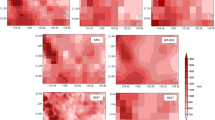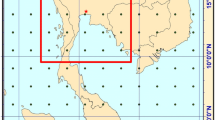Abstract
Modeling of large rainfall events plays an important role in water resources and floodplain management. Rainfall is resulted from complex interactions between climate factors (air moisture, temperature, wind speed, etc.) and land surface (topography, soil, land cover, etc.). Therefore, deriving accurate areal rainfall is not only relied on atmospheric boundary conditions, but also on the reliability and availability of soils, topography, and vegetation data. Consequently, uncertainties in both atmospheric and land surface conditions contributes to rainfall model errors. In this study, a blended technique combining dynamical and statistical downscaling has been explored. The proposed downscaling approach uses input provided from three different global reanalysis data sets including ERA-Interim, ERA20C, and CFSR. These reanalysis atmospheric data are hybridly downscaled by means of the Weather Research and Forecasting (WRF) model, which is followed by the application of an artificial neural network (ANN) model to further downscale the WRF output to a finer resolution over the studied region. The proposed technique has been applied to the third largest river basin in Vietnam, the Sai Gon–Dong Nai Rivers Basin; and the calibration and validation show the simulation results agreed well with observation data. Results of this study suggest that the proposed approach can improve the accuracy of simulated data, as it merges model simulations with observations over the modeled region. Another highlight of this approach is inexpensive computational demand on both computation times and output storage.















Similar content being viewed by others
References
Benjamin SG, Dévényi D, Weygandt SS, Brundage KJ, Brown JM, Grell GA, Kim D, Schwartz BE, Smirnova TG, Smith TL, Manikin GS (2004) An hourly assimilation–forecast cycle: the RUC. Mon Weather Rev 132(2):495–518
Berrisford P, Dee DPKF, Fielding K, Fuentes M, Kallberg P, Kobayashi S, Uppala S (2009) The ERA-interim archive. ERA Rep Ser 1:1–16
Bougeault P, Lacarrere P (1989) Parameterization of orography-induced turbulence in a mesobeta-scale model. Mon Weather Rev 117(8):1872–1890
Brierley P (1998) Some practical application of neural networks in the electricity industry, Eng. D Thesis. Cranfield University, Cranfield
Burlando P, Rosso R (2002) Effects of transient climate change on basin hydrology. 1. Precipitation scenarios for the Arno River, central Italy. Hydrol Process 16(6):1151–1175
Chou MD, Suarez MJ (1999) A solar radiation parameterization (CLIRAD-SW) for atmospheric studies. NASA Tech. Memo NASA/TM-1999-104606, 40
Compo GP, Whitaker JS, Sardeshmukh PD (2006) Feasibility of a 100-year reanalysis using only surface pressure data. Bull Am Meteorol Soc 87(2):175–190
Coulibaly P (2004) Downscaling daily extreme temperatures with genetic programming. Geophys Res Lett 31:L16203. https://doi.org/10.1029/2004GL020075
Courtier P, Thepaut JN, Hollingsworth A (1994) A strategy for operational implementation of 4DVar using an incremental approach. Q J Roy Meteorol Soc 120:13671387
Cuong HV, Toan TQ (2019) Assessment of hydro-climatological drought conditions for Hong-Thai Binh river watershed in Vietnam using high-resolution model simulation. Vietnam J Sci Technol Eng 61(2):90–96
Dee DP, Uppala SM, Simmons AJ, Berrisford P, Poli P, Kobayashi S, Andrae U, Balmaseda MA, Balsamo G, Bauer DP, Bechtold P (2011) The ERA-Interim reanalysis: Configuration and performance of the data assimilation system. Q J R Meteorol Soc 137(656):553–597
Fletcher DS, Goss E (1993) Forecasting with neural networks: an application using bankruptcy data. Inf Manag 24:159–167
Fowler HJ, Blenkinsop S, Tebaldi C (2007) Linking climate change modelling to impacts studies: recent advances in downscaling techniques for hydrological modelling. Int J Climatol 27(12):1547–1578
Fuka DR, Walter MT, MacAlister C, Degaetano AT, Steenhuis TS, Easton ZM (2014) Using the Climate Forecast System Reanalysis as weather input data for watershed models. Hydrol Process 28(22):5613–5623
Gebregiorgis AS, Hossain F (2012) Understanding the dependence of satellite rainfall uncertainty on topography and climate for hydrologic model simulation. IEEE Trans Geosci Remote Sens 51(1):704–718
Glahn HR, Lowry DA (1972) The use of model output statistics (MOS) in objective weather forecasting. J Appl Meteorol 11:1203–1211
Goyal MK, Ojha CSP (2011) Evaluation of linear regression methods as downscaling tools in temperature projections over the Pichola Lake Basin in India. Hydrol Process 25(9):1453–1465
Han J, Pan HL (2011) Revision of convection and vertical diffusion schemes in the NCEP Global Forecast System. Weather Forecast 26(4):520–533
Hashmi MZ, Shamseldin AY, Melville BW (2011a) Statistical downscaling of watershed precipitation using gene expression programming (gep). Environ Model Softw 26(12):1639–1646
Hashmi MZ, Shamseldin AY, Melville BW (2011b) Comparison of SDSM and LARS-WG for simulation and downscaling of extreme precipitation events in a watershed. Stoch Environ Res Risk Assess 25(4):475–484
Hashmi MZ, Shamseldin AY, Melville BW (2013) Statistically downscaled probabilistic multi-model ensemble projections of precipitation change in a watershed. Hydrol Process 27(7):1021–1032
Ho C, Trinh T, Nguyen A, Nguyen Q, Ercan A, Kavvas ML (2019) Reconstruction and evaluation of changes in hydrologic conditions over a transboundary region by a regional climate model coupled with a physically-based hydrology model: application to Thao river watershed. Sci Total Environ 668:768–779
Ho C, Nguyen A, Ercan A, Kavvas ML, Nguyen V, Nguyen T (2020) Assessment of atmospheric conditions over the Hong Thai Binh river watershed by means of dynamically downscaled ERA-20C reanalysis data. J Water Clim Change 11(2):540–555
Hong SY, Dudhia J, Chen SH (2004) A revised approach to ice microphysical processes for the bulk parameterization of clouds and precipitation. Mon Weather Rev 132(1):103–120
Jang S, Kavvas ML (2015) Downscaling global climate simulations to regional scales: statistical downscaling versus dynamical downscaling. J Hydrol Eng 20(1):A4014006
Jang S, Kavvas ML, Ishida K, Trinh T, Ohara N, Kure S, Chen ZQ, Anderson ML, Matanga G, Carr KJ (2017) A performance evaluation of dynamical downscaling of precipitation over northern California. Sustainability 9(8):1457
Kavvas ML, Kure S, Chen ZQ, Ohara N, Jang S (2013) WEHY-HCM for modeling interactive atmospheric-hydrologic processes at watershed scale. I: Model description. J Hydrol Eng 18(10):1262–1271
Kjellström E, Bärring L, Nikulin G, Nilsson C, Persson G, Strandberg G (2016) Production and use of regional climate model projections—a Swedish perspective on building climate services. Clim Serv 2:15–29
Krishnamurti TN, Jha B, Rasch PJ, Ramanathan V (1997) A high resolution global reanalysis highlighting the winter monsoon. Part I, reanalysis fields. Meteorol Atmos Phys 64(3):123–150
Lin Y, Colle BA (2011) A new bulk microphysical scheme that includes riming intensity and temperature-dependent ice characteristics. Mon Weather Rev 139(3):1013–1035
Liu Y, Fan K (2014) An application of hybrid downscaling model to forecast summer precipitation at stations in China. Atmos Res 143:17–30
Lledó L, Lead T, Dubois J (2013) A study of wind speed variability using global reanalysis data. AWS Truepower LLC, pp 1–12
Minh PT, Tuyet BT, Thao TTT (2018) Application of ensemble Kalman filter in WRF model to forecast rainfall on monsoon onset period in South Vietnam. Vietnam J Earth Sci 40(4):367–394
Moriasi DN, Gitau MW, Daggupati P (2015) Hydrologic and water quality models: performance measures and evaluation. Trans ASBE 58:1763–1785
Nguyen-Thi HA, Matsumoto J, Ngo-Duc T, Endo N (2012) A climatological study of tropical cyclone rainfall in Vietnam. Sola 8:41–44
Nguyen-Xuan T, Ngo-Duc T, Kamimera H, Trinh-Tuan L, Matsumoto J, Inoue T, Phan-Van T (2016) The Vietnam gridded precipitation (VnGP) dataset: construction and validation. SOLA 12:291–296
Pilling CG, Jones JAA (2002) The impact of future climate change on seasonal discharge, hydrological processes and extreme flows in the Upper Wye experimental catchment, Mid-Wales. Hydrol Process 16(6):1201–1213
Poli P, Hersbach H, Tan D, Dee D, Thepaut JN, Simmons A, Peubey C, Laloyaux P, Komori T, Berrisford P, Dragani R (2013) The data assimilation system and initial performance evaluation of the ECMWF pilot reanalysis of the 20th-century assimilating surface observations only (ERA-20C). European Centre for Medium Range Weather Forecasts, Reading
Poli P, Hersbach H, Dee DP, Berrisford P, Simmons AJ, Vitart F, Laloyaux P, Tan DG, Peubey C, Thépaut JN, Trémolet Y (2016) ERA-20C: an atmospheric reanalysis of the twentieth century. J Clim 29(11):4083–4097
Raghavan SV, Vu MT, Liong SY (2016) Regional climate simulations over Vietnam using the WRF model. Theor Appl Climatol 126(1–2):161–182
Raje D, Mujumdar PP (2011) A comparison of three methods for downscaling daily precipitation in the Punjab region. Hydrol Process 25(23):3575–3589
Reichler T, Kim J (2008) Uncertainties in the climate mean state of global observations, reanalyses, and the GFDL climate model. J Geophys Res 113:D05106. https://doi.org/10.1029/2007JD009278
Rossi G, Vega T, Bonaccorso B (eds) (2007) Methods and tools for drought analysis and management, vol 62. Springer Science and Business Media, New York
Saha S, Moorthi S, Pan HL, Wu X, Wang J, Nadiga S, Tripp P, Kistler R, Woollen J, Behringer D, Liu H (2010) The NCEP climate forecast system reanalysis. Bull Am Meteorol Soc 91(8):1015–1058
Schoof JT, Pryor SC (2001) Downscaling temperature and precipitation: a comparison of regression-based methods and artificial neural networks. Int J Climatol 21(7):773–790
Shepherd TG (2014) Atmospheric circulation as a source of uncertainty in climate change projections. Nat Geosci 7(10):703–708
Skamarock WC, Klemp JB, Dudhia J, Gill DO, Barker DM, Wang W, Powers JG (2005) A description of the advanced research WRF version 2 (No. NCAR/TN-468+STR). University Corporation for Atmospheric Research
Tran QA, Taniguchi K (2018) Coupling dynamical and statistical downscaling for high-resolution rainfall forecasting: Case study of the Red River Delta. Vietnam Prog Earth Planet Sci 5(1):1–18
Trinh T, Ishida K, Fischer I, Jang S, Darama Y, Nosacka J, Brown K, Kavvas ML (2016) New methodology to develop future flood frequency under changing climate by means of physically based numerical atmospheric-hydrologic modeling. J Hydrol Eng 21(4):04016001
Trinh T, Ishida K, Kavvas ML, Ercan A, Carr K (2017) Assessment of 21st century drought conditions at Shasta Dam based on dynamically projected water supply conditions by a regional climate model coupled with a physically-based hydrology model. Sci Total Environ 586:197–205
Trinh T, Ho C, Do N, Ercan A, Kavvas ML (2020) Development of high-resolution 72 h precipitation and hillslope flood maps over a tropical transboundary region by physically based numerical atmospheric–hydrologic modeling. J Water Clim Change 11(S1):387–406
Veerse F, Thepaut JN (1998, Part B) Multiple-truncation incremental approach for four-dimensional variational data assimilation. Q J R Meteorol Soc 124(550):1889–1908
Walton DB, Sun F, Hall A, Capps S (2015) A hybrid dynamical–statistical downscaling technique. Part I: development and validation of the technique. J Clim 28(12):4597–4617
Wang W, Xie P, Yoo SH, Xue Y, Kumar A, Wu X (2011) An assessment of the surface climate in the NCEP climate forecast system reanalysis. Clim Dyn 37(7):1601–1620
Wilby RL, Wigley TM (1997) Downscaling general circulation model output: a review of methods and limitations. Prog Phys Geogr 21(4):530–548
Wilby RL, Dawson CW, Barrow EM (2002) SDSM—a decision support tool for the assessment of regional climate change impacts. Environ Model Softw 17(2):147–159
Yang TC, Yu PS, Wei CM, Chen ST (2011) Projection of climate change for daily precipitation: a case study in Shih-Men reservoir catchment in Taiwan. Hydrol Process 25(8):1342–1354
Yang T, Li H, Wang W, Xu CY, Yu Z (2012) “Statistical downscaling of extreme daily precipitation, evaporation, and temperature and construction of future scenarios. Hydrol Process 26(23):3510–3523
Yokoi S, Matsumoto J (2008) Collaborative effects of cold surge and tropical depression-type disturbance on heavy rainfall in central Vietnam. Mon Weather Rev 136(9):3275–3287
Acknowledgements
This research was funded by Ho Chi Minh City’s Department of Science and Technology (HCMC-DOST) and Institute for Computational Science and Technology (ICST) under the grant number 16/2020/HĐ-QPTKHCN. The authors also would like to thank the anonymous reviewers for their valuable and constructive comments to improve our manuscript.
Author information
Authors and Affiliations
Corresponding author
Ethics declarations
Conflict of interest
The authors declare that they have no known competing financial interests or personal relationships that could have appeared to influence the work reported in this paper.
Additional information
Publisher's Note
Springer Nature remains neutral with regard to jurisdictional claims in published maps and institutional affiliations.
Rights and permissions
About this article
Cite this article
Trinh, T., Do, N., Nguyen, V.T. et al. Modeling high-resolution precipitation by coupling a regional climate model with a machine learning model: an application to Sai Gon–Dong Nai Rivers Basin in Vietnam. Clim Dyn 57, 2713–2735 (2021). https://doi.org/10.1007/s00382-021-05833-6
Received:
Accepted:
Published:
Issue Date:
DOI: https://doi.org/10.1007/s00382-021-05833-6




